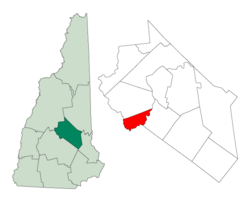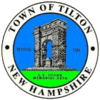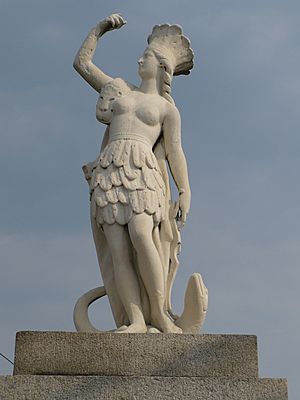Tilton, New Hampshire facts for kids
Quick facts for kids
Tilton, New Hampshire
|
||
|---|---|---|
|
Town
|
||

Downtown Tilton
|
||
|
||

Location in Belknap County, New Hampshire
|
||
| Country | United States | |
| State | New Hampshire | |
| County | Belknap | |
| Incorporated | 1869 | |
| Villages | ||
| Area | ||
| • Total | 11.94 sq mi (30.93 km2) | |
| • Land | 11.15 sq mi (28.87 km2) | |
| • Water | 0.80 sq mi (2.06 km2) 6.67% | |
| Elevation | 443 ft (135 m) | |
| Population
(2020)
|
||
| • Total | 3,962 | |
| • Density | 356/sq mi (137.3/km2) | |
| Time zone | UTC-5 (Eastern) | |
| • Summer (DST) | UTC-4 (Eastern) | |
| ZIP codes |
03276, 03298, 03299
|
|
| Area code(s) | 603 | |
| FIPS code | 33-77060 | |
| GNIS feature ID | 0873739 | |
Tilton is a town in New Hampshire, United States. It's located right by the Winnipesaukee River in Belknap County. In 2020, about 3,962 people lived there. That's more than the 3,567 people who lived there in 2010!
Tilton includes its own village, plus parts of Winnisquam and Lochmere. It's also home to the Tilton School, a private school that helps students get ready for college.
Contents
The History of Tilton
Long ago, the area where Tilton is now was part of a town called Sanbornton. People knew it as "Sanbornton Bridge" or "Bridge Village". These names came from a bridge built in 1763. This bridge crossed the Winnipesaukee River from Canterbury to Sanbornton, leading to what is now Main Street in Tilton.
In 1869, this area became its own town and was named Tilton. It was named after Nathaniel Tilton (1726–1814). His great-grandson, Charles E. Tilton (1827–1901), was a very wealthy citizen. Charles owned textile mills in the area. Nathaniel Tilton started an iron foundry and the first hotel, called the Dexter House.
Charles E. Tilton's Gifts to the Town
Charles E. Tilton gave many unique statues to the town. His large estate is now part of the Tilton School. Tilton Hall, which was his mansion built in 1861, now holds the Lucian Hunt Library. The building where his carriages were kept was turned into the Helene Grant Daly Art Center in 1980.
Charles E. Tilton also gave the town its most famous landmark: the hilltop Memorial Arch. This arch is actually in the nearby town of Northfield, just across the Winnipesaukee River from Tilton's center. It looks like a triumphal arch from Ancient Rome. It was built in the late 1800s to remember his ancestors. The arch is made of Concord granite and stands 50 feet (15 meters) high and 40 feet (12 meters) wide.
Tilton's Geography
Tilton covers about 11.9 square miles (30.9 square kilometers) in total. About 11.1 square miles (28.9 square kilometers) is land, and 0.8 square miles (2.1 square kilometers) is water. This means about 6.67% of the town is water. The Winnipesaukee River flows through Tilton. The town is also next to Silver Lake and Lake Winnisquam on its eastern side.
The highest point in Tilton is about 866 feet (264 meters) above sea level. This spot is along the town's northern border, near the top of Calef Hill.
Getting Around Tilton
Tilton is easy to reach because several major roads pass through it. These include Interstate 93, U.S. Route 3, and state routes 11, 132, and 140.
Tilton is often called the "gateway" to the Lakes Region of New Hampshire. A large area with many shops and stores has grown up where these routes meet, right off Exit 20 of I-93. The older, historic part of Tilton is a short distance west of this new shopping area, on the north side of the Winnipesaukee River.
Neighboring Towns
Tilton shares its borders with these towns:
- Sanbornton (to the north)
- Belmont (to the east)
- Northfield (to the south)
- Franklin (to the west)
Population and People
| Historical population | |||
|---|---|---|---|
| Census | Pop. | %± | |
| 1870 | 1,147 | — | |
| 1880 | 1,232 | 7.4% | |
| 1890 | 1,521 | 23.5% | |
| 1900 | 1,926 | 26.6% | |
| 1910 | 1,866 | −3.1% | |
| 1920 | 2,014 | 7.9% | |
| 1930 | 1,712 | −15.0% | |
| 1940 | 1,738 | 1.5% | |
| 1950 | 2,085 | 20.0% | |
| 1960 | 2,137 | 2.5% | |
| 1970 | 2,579 | 20.7% | |
| 1980 | 3,387 | 31.3% | |
| 1990 | 3,240 | −4.3% | |
| 2000 | 3,477 | 7.3% | |
| 2010 | 3,567 | 2.6% | |
| 2020 | 3,962 | 11.1% | |
| U.S. Decennial Census | |||

In 2010, there were 3,567 people living in Tilton. These people lived in 1,462 homes, and 888 of those were families. Most people (96.2%) were White. A smaller number were Asian (1.4%) or African American (0.4%). About 1.1% of the population was Hispanic or Latino.
About 17.9% of the people in Tilton were under 18 years old. The average age was 45.2 years. For every 100 females, there were about 106 males.
The estimated average yearly income for a household was about $54,276 between 2011 and 2015. For families, it was about $59,754. About 8.3% of the population lived below the poverty line.
Famous People from Tilton
- John Charles Daly (1914–1991) – A famous television personality and host of What's My Line?. He went to Tilton School.
- Mary Baker Eddy (1821–1910) – The person who started Christian Science.
- John W. Gowdy (1869–1963) – A bishop in the Methodist Church.
- Jonathan Page (born 1976) – An American champion cyclocross bike racer.
- Harry Taylor (1862–1930) – A major general in the US Army and Chief of Engineers.
Places to Visit
- New Hampshire Historical Marker No. 149: Lochmere Archeological District – This marker tells about an important historical site.
- New Hampshire Historical Marker No. 262: Charles E. Tilton's Legacy – This marker explains the lasting impact of Charles E. Tilton on the town.
Images for kids
See also
 In Spanish: Tilton (Nuevo Hampshire) para niños
In Spanish: Tilton (Nuevo Hampshire) para niños







